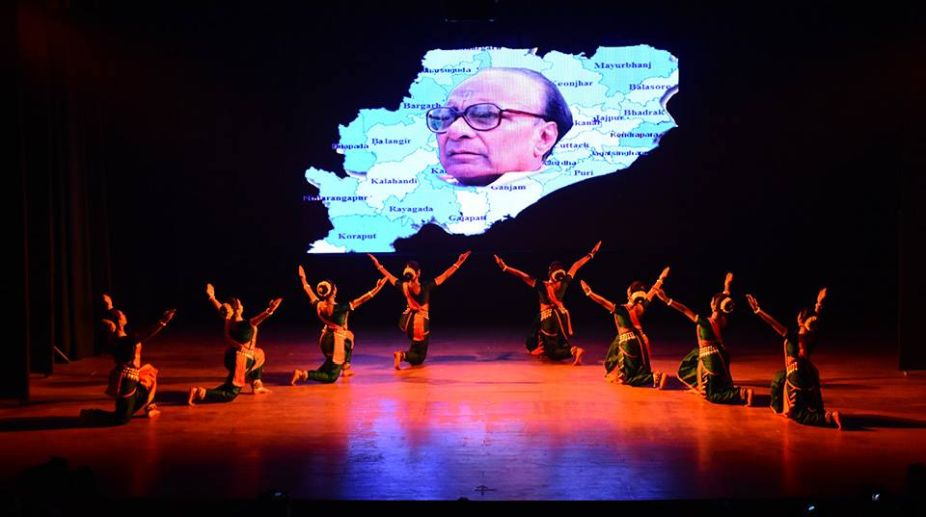Guinness World Record of ‘Classical Dance Relay Marathon’ in MP
Officials of the Guinness Records handed over the certificate of the world record to Madhya Pradesh Chief Minister Dr Mohan Yadav at the festival on Thursday evening.

(Photo: Facebook)
The OMC Guru Kelucharan Mohapatra Award Festival started with great fanfare at Rabindra Mandap, Bhubaneswar, recently as connoisseurs and discerning audiences gathered in large numbers to witness it. The objective of organising this festival was to expose the audience of Odisha to the best classical music and dance, and also inspire the youth to internalise the soft power and subtle flavours of the classical arts.
The first presentation in the inaugural evening was Ekatatwa. Ekatatwawas a pure dance piece choreographed with the amalgamation of Odissi, Kathak and Bharatanatyam. It was a production, where art and artist united in pursuit of supreme bliss, celebrating the use of the body through all of its movements to reach beyond the plane of the mundane, in search of a higher existence.
Advertisement
Ekatatwa was the journey of a human in search of the ultimate. In the beginning of time humans prayed to natural phenomena and that was portrayed through the movement of Surya. Uma Dogra showed dawn or Usha, when the red orb of the sun rises in all its glory like a beautiful maiden, spreading over all of nature and causing it to wake up and blossom.
Advertisement
Daksha Mushroowala took up from where Dogra left, showing the power of the sun in the perfect idiom of Odissi in the style advocated by Guru Kelucharan Mohapatra. It was the turn of Vaibhav Arekar, a top Bharatanatyam performer cum mentor to complete Surya’s journey from the eastern sky to the West.
The ever troubled hearts of mankind created iconic gods, all from their own imagination to give them happiness and succour. The realisation that came to humans to get back their mental happiness was portrayed through imagery, which was again drawn from nature.The quest for that source of eternal bliss lies within the self and it brought out beautifully with the shloka, Aradhyami Atma Lingamby Adi Shankaracharya.
The lotus of every soul within is clamouring to be awakened. The trio portrayed the joy of life through a tarana ending with a Sufi song. The message was brought home through the vocabulary of dance. Ekatatwa was a common principle that strung together three dancers cum choreographers — Daksha Mashroowala, Uma Dogra and Vaibhav Areka, representatives of three classical dance styles, Odissi, Kathak and Bharatnatyam. The music director of the presentation was Manoj Desai who blended the percussion instruments by playing them in a beautiful way — one heard the tabla bols as well as mridangam bols.
The piece was remarkable for its fluid grace, immaculate body movements with amazing precision and charming gestures and postures. The second presentation of the evening was an instrumental jugalbandi of flute by Annada Prasanna Pattanaik and veena by Puspa Kashinath. Pattanaik — a well-known flautist famed for his experimental playing — smoothly transited to higher octave while playing various Indian classical ragas.
Kashinath proved equal to Ananda for her handling of the veena. She deftly matched up to the jugalbandi with her music partner to produce aesthetic beauty. Udayaraj Karpur enjoyed accompanying the duo on the tabla. The second evening of the OMC GKCM Award Festival was a beautiful blend of traditional repertoire and innovative compositions featuring Navia Natarajan, eminent Bharatnatyam dancer, and a tabla recital by the talented Ojas Adhiya.
The first presentation of Nataranjan was Parashakti, which explored the dualistic nature of Devi. Devi Bhagavata Mahapurana states that Adi Parashakti is the original creator, observer and destroyer of the universe followed by one invocatory piece of pure Bharatnatyan dance. She drew from Adi Shankaracharya’s Navaratnamallika Lalitopakyanamof Somadeva Sharma. To invoke the beauty of Devi and annihilate the fierce demon, verses from Lalitipakyanam were chanted. The dance composition was by Natarajan while the music was composed by D Srivasta. If she had established herself in this piece, then the varnam, Swami nan uddan adi mayi showing her pining for Lord Shiva entrenched her deeply in the hearts of the audience. Ragam Nata Kurunji in Aditalam amply displayed that aspect.
The art lovers present in the auditorium were mesmerised by the superbly graceful and enchanting performace of Natarajan who was given thunderous applause. The second programme of the evening was the tabla recital by percussionist Adhiya. His composition impressed connoisseurs through the magical rhythm of fingers with a fine blend of Toda, Tukda, Tihyee, Chakradhar, Paran in teentalwith 16 beats. He was accompanied on the harmonium by Siddhesh Bicholkar.
Tabalia Ojas Adhiya fulfilled audience expectations with his superb rendition on his percussion instrument. The awardees of the Guru Kelucharan Mohapatra Award Festival 2017 were Shyamamani Devi and Guru Dhruba Charan Biswal for music and dance respectively.
The recipients of Guru Kelucharan Mohapatra Yuva Pratibha Samman were Odissi vocalist Jatin Kumar Sahu, Bharatanatyam dancer Jyotsna Jagannathan, and Odissi dancers Namrata Mehta and Lingaraj Pradhan.
Advertisement
Officials of the Guinness Records handed over the certificate of the world record to Madhya Pradesh Chief Minister Dr Mohan Yadav at the festival on Thursday evening.
The capital city witnessed an enchanting evening of classical dance at Samasrava, organised by Manasija, a non-profit dedicated to promoting Indian art and culture, recently.
Actress Sheeba Chaddha recently opened up about her childhood connection to the script of “Bandish Bandits.”.
Advertisement
